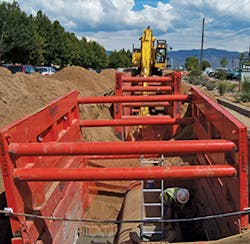There are many challenges contractors face on the job site that necessitate safety practices and technologies, points out Eric J. Herron, global technology marketing consultant, Construction Technology & Solutions–Caterpillar.
Among them: unseen personnel or bystanders; operator fatigue; blind spots and obstructed views; tip overs; damaged existing utilities; collisions with objects or other machines; and poor site conditions such as soft underfoot, unstable soils, and opened excavations.
“Safety is everything. There’s never a compromise,” points out George Chaney, skid-steer loader/compact track loader international sales manager with JCB.
“If a company’s safety performance doesn’t meet the criteria of a client, then they’re not going to get the job,” says Zach Knoop, senior safety consultant for Caterpillar.
A recent visit to a Texas petrochemical facility drove home the importance of safety equipment and practices on the job for Chaney. His experience speaks to how important it is for grading and excavation contractors to invest in and use safety technology and practices in order to secure good jobs and execute them safely.
“They would not allow you on the job period unless you participated in their introduction safety program, which was very formalized,” says Chaney.
Chaney had been at the facility to train the company’s trainers on some JCB machines.
“We were going through the formal operation of the machine, the safety interlocks, and the owners’/operators’ manuals, and they in turn would provide a formalized safety program for their own employees,” he adds.
At the Texas facility, everyone is required to wear hard hats, high-visibility vests, safety glasses, and steel-toe work boots.
“You had to walk within the allocated areas which were normally delineated with lines on the actual job sites or in the case of outside, areas that were marked for pedestrian and for people movement versus machine movement,” says Chaney.
Employees are required to sign in and out each day, preferably with a scanned ID card.
All employees attend safety training and equipment training with certificates of completion on file with the human resources department.
OSHA requirements are to be followed with respect to wearing vests, hard hats, safety glasses, work boots, and a full body harness if the worker is being elevated up to more than six feet, Chaney points out.
“Up to six feet, it is recommended they have a lanyard for any piece of moving machinery. Ladders are excluded,” he says.
Loose clothing and jewelry that dangles should not be worn around moving machinery, Chaney adds.
Additionally, companies also should conduct periodic random drug and alcohol testing of all employees, Chaney notes.
Industry experts point out that the most important part on a piece of construction equipment is its operator’s manual.
While many seasoned equipment operators feel very comfortable around heavy equipment, “unfortunately, these comfort levels can sometimes lead to shortcuts and sidesteps that can be dangerous and even deadly for operators and those working around them,” points out Tim Boulds, construction product operations manager for Kubota.
“There are many safety precautions that need to be taken into account when operating equipment to avoid common oversights, and it starts with the basics such as reading the operator’s manual and conducting safety checks,” he says.
“Reading an operator’s manual may seem like a tedious task to a veteran contractor,” adds Boulds. “However, it’s important because manufacturers make changes every year. If you don’t familiarize yourself with a new machine and its features, accidents are exponentially more likely to occur.”



